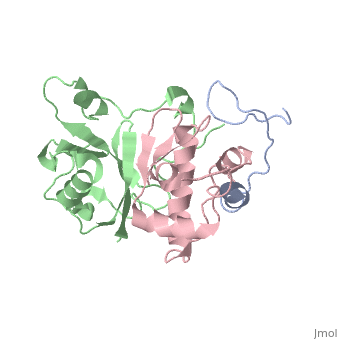2ma9
From Proteopedia
(Difference between revisions)
| Line 4: | Line 4: | ||
== Structural highlights == | == Structural highlights == | ||
<table><tr><td colspan='2'>[[2ma9]] is a 3 chain structure with sequence from [https://en.wikipedia.org/wiki/Homo_sapiens Homo sapiens] and [https://en.wikipedia.org/wiki/Human_immunodeficiency_virus_type_1_(NEW_YORK-5_ISOLATE) Human immunodeficiency virus type 1 (NEW YORK-5 ISOLATE)]. Full experimental information is available from [http://oca.weizmann.ac.il/oca-bin/ocashort?id=2MA9 OCA]. For a <b>guided tour on the structure components</b> use [https://proteopedia.org/fgij/fg.htm?mol=2MA9 FirstGlance]. <br> | <table><tr><td colspan='2'>[[2ma9]] is a 3 chain structure with sequence from [https://en.wikipedia.org/wiki/Homo_sapiens Homo sapiens] and [https://en.wikipedia.org/wiki/Human_immunodeficiency_virus_type_1_(NEW_YORK-5_ISOLATE) Human immunodeficiency virus type 1 (NEW YORK-5 ISOLATE)]. Full experimental information is available from [http://oca.weizmann.ac.il/oca-bin/ocashort?id=2MA9 OCA]. For a <b>guided tour on the structure components</b> use [https://proteopedia.org/fgij/fg.htm?mol=2MA9 FirstGlance]. <br> | ||
| - | </td></tr><tr id='resources'><td class="sblockLbl"><b>Resources:</b></td><td class="sblockDat"><span class='plainlinks'>[https://proteopedia.org/fgij/fg.htm?mol=2ma9 FirstGlance], [http://oca.weizmann.ac.il/oca-bin/ocaids?id=2ma9 OCA], [https://pdbe.org/2ma9 PDBe], [https://www.rcsb.org/pdb/explore.do?structureId=2ma9 RCSB], [https://www.ebi.ac.uk/pdbsum/2ma9 PDBsum], [https://prosat.h-its.org/prosat/prosatexe?pdbcode=2ma9 ProSAT]</span></td></tr> | + | </td></tr><tr id='method'><td class="sblockLbl"><b>[[Empirical_models|Method:]]</b></td><td class="sblockDat" id="methodDat">Solution NMR</td></tr> |
| + | <tr id='resources'><td class="sblockLbl"><b>Resources:</b></td><td class="sblockDat"><span class='plainlinks'>[https://proteopedia.org/fgij/fg.htm?mol=2ma9 FirstGlance], [http://oca.weizmann.ac.il/oca-bin/ocaids?id=2ma9 OCA], [https://pdbe.org/2ma9 PDBe], [https://www.rcsb.org/pdb/explore.do?structureId=2ma9 RCSB], [https://www.ebi.ac.uk/pdbsum/2ma9 PDBsum], [https://prosat.h-its.org/prosat/prosatexe?pdbcode=2ma9 ProSAT]</span></td></tr> | ||
</table> | </table> | ||
== Function == | == Function == | ||
[https://www.uniprot.org/uniprot/VIF_HV1N5 VIF_HV1N5] Counteracts the innate antiviral activity of human APOBEC3F and APOBEC3G. Forms a complex with host APOBEC3F and APOBEC3G thus preventing the entry of these lethally hypermutating enzymes into progeny virions. Recruits an active E3 ubiquitin ligase complex composed of elongin BC, CUL5, and RBX2 to induce polyubiquitination of APOBEC3G and APOBEC3F. In turn, they are directed to the 26S proteasome for degradation. Vif interaction with APOBEC3G also blocks its cytidine deaminase activity in a proteasome-independent manner, suggesting a dual inhibitory mechanism. May interact directly with APOBEC3G mRNA in order to inhibit its translation. Seems to play a role in viral morphology by affecting the stability of the viral nucleoprotein core. Finally, Vif also contributes to the G2 cell cycle arrest observed in HIV infected cells (By similarity).<ref>PMID:8184544</ref> <ref>PMID:14557625</ref> | [https://www.uniprot.org/uniprot/VIF_HV1N5 VIF_HV1N5] Counteracts the innate antiviral activity of human APOBEC3F and APOBEC3G. Forms a complex with host APOBEC3F and APOBEC3G thus preventing the entry of these lethally hypermutating enzymes into progeny virions. Recruits an active E3 ubiquitin ligase complex composed of elongin BC, CUL5, and RBX2 to induce polyubiquitination of APOBEC3G and APOBEC3F. In turn, they are directed to the 26S proteasome for degradation. Vif interaction with APOBEC3G also blocks its cytidine deaminase activity in a proteasome-independent manner, suggesting a dual inhibitory mechanism. May interact directly with APOBEC3G mRNA in order to inhibit its translation. Seems to play a role in viral morphology by affecting the stability of the viral nucleoprotein core. Finally, Vif also contributes to the G2 cell cycle arrest observed in HIV infected cells (By similarity).<ref>PMID:8184544</ref> <ref>PMID:14557625</ref> | ||
| - | <div style="background-color:#fffaf0;"> | ||
| - | == Publication Abstract from PubMed == | ||
| - | The HIV-1 viral infectivity factor (Vif) neutralizes cell-encoded antiviral APOBEC3 proteins by recruiting a cellular ElonginB (EloB)/ElonginC (EloC)/Cullin5-containing ubiquitin ligase complex, resulting in APOBEC3 ubiquitination and proteolysis. The suppressors-of-cytokine-signalling-like domain (SOCS-box) of HIV-1 Vif is essential for E3 ligase engagement, and contains a BC box as well as an unusual proline-rich motif. Here, we report the NMR solution structure of the Vif SOCS-ElonginBC (EloBC) complex. In contrast to SOCS-boxes described in other proteins, the HIV-1 Vif SOCS-box contains only one alpha-helical domain followed by a beta-sheet fold. The SOCS-box of Vif binds primarily to EloC by hydrophobic interactions. The functionally essential proline-rich motif mediates a direct but weak interaction with residues 101-104 of EloB, inducing a conformational change from an unstructured state to a structured state. The structure of the complex and biophysical studies provide detailed insight into the function of Vif's proline-rich motif and reveal novel dynamic information on the Vif-EloBC interaction. | ||
| - | |||
| - | Insight into the HIV-1 Vif SOCS-box-ElonginBC interaction.,Lu Z, Bergeron JR, Atkinson RA, Schaller T, Veselkov DA, Oregioni A, Yang Y, Matthews SJ, Malim MH, Sanderson MR Open Biol. 2013 Nov 13;3(11):130100. doi: 10.1098/rsob.130100. PMID:24225024<ref>PMID:24225024</ref> | ||
| - | |||
| - | From MEDLINE®/PubMed®, a database of the U.S. National Library of Medicine.<br> | ||
| - | </div> | ||
| - | <div class="pdbe-citations 2ma9" style="background-color:#fffaf0;"></div> | ||
==See Also== | ==See Also== | ||
Current revision
HIV-1 Vif SOCS-box and Elongin BC solution structure
| |||||||||||
Categories: Homo sapiens | Large Structures | Atkinson RA | Bergeron JR | Lu Z | Malim MH | Matthews SJ | Oregioni A | Sanderson MR | Schaller T | Veselkov DA | Yang Y

